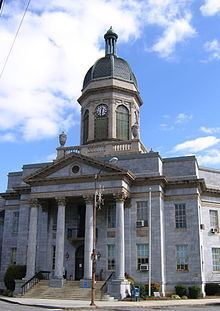Founded 1839 Population 27,218 (2013) | Area 1,210 km² | |
 | ||
Website www.cherokeecounty-nc.gov Points of interest | ||
Cherokee County is the westernmost county in the U.S. state of North Carolina. As of the 2010 census, the population was 27,444. Its county seat is Murphy.
Contents
- Map of Cherokee County NC USA
- History
- Law and government
- Geography
- Indian reservation
- National protected area
- Adjacent counties
- Major highways
- Demographics
- Towns
- Census designated place
- Unincorporated communities
- Townships
- References
Map of Cherokee County, NC, USA
History
The county was formed in 1839 from the western part of Macon County. It was named for the Cherokee Native Americans, some of whom still live in the area.
In 1861 the southeastern part of Cherokee County became Clay County. In 1872 its northeastern part was also separated and became Graham County.
Law and government
Cherokee County is a member of the regional Southwestern Commission council of governments.
Geography
According to the U.S. Census Bureau, the county has a total area of 467 square miles (1,210 km2), of which 455 square miles (1,180 km2) is land and 11 square miles (28 km2) (2.4%) is water.
Located in the southern Appalachian Mountains, Cherokee County contains a varied natural landscape. Portions of the county fall within the boundaries of the Nantahala National Forest, and the Hiawassee River - a tributary of the Tennessee River - flows through the county from southeast to northwest.
In April 1974, parts of Cherokee County were affected by a historic weather event - the 1974 Super Outbreak of tornadoes, which affected parts of 13 states and was the second-largest such event to be recorded in the U.S.
Indian reservation
Portions of the Qualla Boundary, also known as the Eastern Cherokee Indian Reservation, are located in Cherokee County. These are non-contiguous and are separate from the main part of the Qualla Boundary, which is in Swain and Jackson counties. The land is exclusive territory of the Eastern Band of Cherokee Indians and is protected by Tribal Police of the Eastern Band of the Cherokee. Following the success of the Harrah's Cherokee Tribal Casino in Cherokee, a second tribal casino on Indian land in the Murphy city limits opened in 2015.
National protected area
Adjacent counties
Major highways
US 64 - the longest highway in North Carolina, and a cross country highway, passes through the county east-west. US 74, which links Chattanooga, Asheville, Charlotte and Wilmington, is a major 4,lane highway through the county. US 19 and US 129 also pass through Cherokee County, providing connections to Atlanta (to the south) and Knoxville (to the north).
Demographics
As of the census of 2000, there were 24,298 people, 10,336 households, and 7,369 families residing in the county. The population density was 53 people per square mile (21/km²). There were 13,499 housing units at an average density of 30 per square mile (11/km²). The racial makeup of the county was 94.82% White, 1.59% Black or African American, 1.63% Native American, 0.28% Asian, 0.01% Pacific Islander, 0.45% from other races, and 1.21% from two or more races. 1.25% of the population were Hispanic or Latino of any race. 34.3% were of American, 10.8% Irish, 10.6% German and 10.3% English ancestry according to Census 2000. 97.7% spoke English and 1.2% Spanish as their first language.
There were 10,336 households out of which 25.60% had children under the age of 18 living with them, 58.80% were married couples living together, 9.30% had a female householder with no husband present, and 28.70% were non-families. 25.70% of all households were made up of individuals and 12.50% had someone living alone who was 65 years of age or older. The average household size was 2.32 and the average family size was 2.76.
In the county, the population was spread out with 20.60% under the age of 18, 6.50% from 18 to 24, 24.40% from 25 to 44, 28.80% from 45 to 64, and 19.70% who were 65 years of age or older. The median age was 44 years. For every 100 females there were 94.20 males. For every 100 females age 18 and over, there were 90.70 males.
The median income for a household in the county was $27,992, and the median income for a family was $33,768. Males had a median income of $26,127 versus $18,908 for females. The per capita income for the county was $15,814. About 11.70% of families and 15.30% of the population were below the poverty line, including 19.20% of those under age 18 and 18.00% of those age 65 or over.
